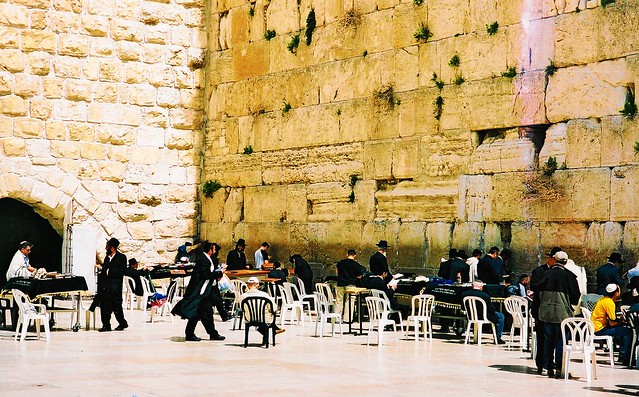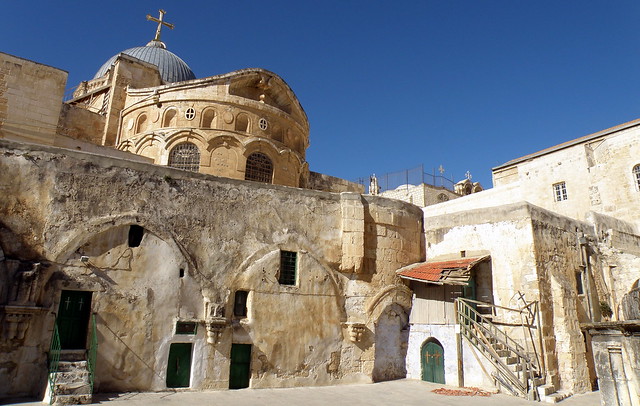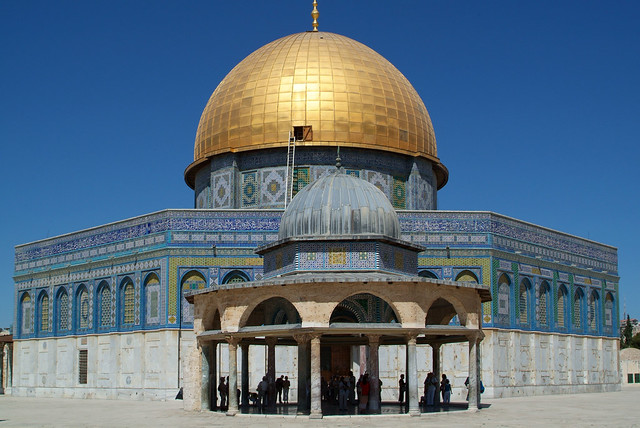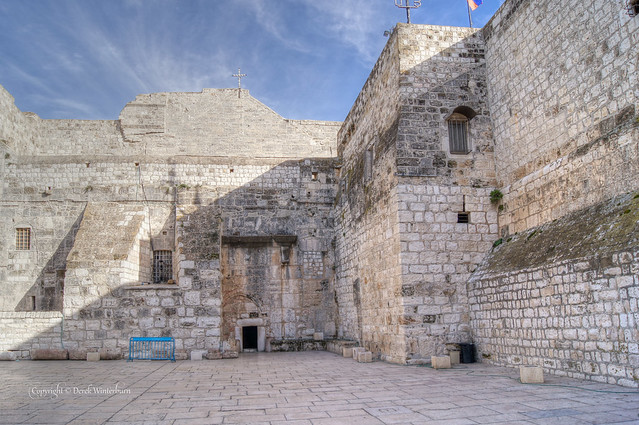Search for Jerusalem hostels at Hostelworld and budget hotels at Agoda.com
At the centre of Jerusalem is the Old City and a history that stretches back more than 3,000 years. At the crossroad of three continents, Jerusalem has been one of the most fought over cities in human history. You do not need to be Jewish, Christian, Muslim, or even religious, to be overwhelmed. Anyone with a sense of history of the human species should be absorbed by the tremendous weight of human civilisation that cloaks nearly every part of the city.
Hostels
Abraham Hostel Jerusalem
The Abraham Hostel in Jerusalem offer great atmosphere, a central location within walking distance to all major sites in Jerusalem, lots of free travel information, and a free breakfast. It is by far the most popular hostel in Jerusalem in terms of pure numbers. The downside is that Abraham's does feel a bit like a hotel. The common area is nice and very large but this is no guarantee to have a social experience since many of the patrons are families or couples. It is still a very good option, but if you're a solo traveller looking for a social place, choose a smaller hostel. Book Abraham Hostel here!
The Post Hostel
The Post is a stylish urban hostel, serving as a cozy and convenient base for travellers. The location is perfect, very close to the Old Town (1km closer than Abraham hostel). They have great facilities and lovely vibe as well as a shakshuka breakfast included! Book the Post Hostel here!
Sights and Highlights
Free Walking Tour
Jumping onto a free walking tour is always a great first activity in a new city. Neweuropetours.eu operate several walking tours in Jerusalem. Their Free Tour of Jerusalem starts at 11 am and 2pm every day of the week and departs from Jaffa gate. The rest of their tours are paid tours.
The Old City
The Old City of Jerusalem represents the heart of the city both historically and spiritually. In a city already divided, the Old City is further divided, culturally and historically, into the Jewish, Armenian, Christian, and Muslim Quarters. There is a tremendous amount to see within the Old City, here are some of the most famous.
The Western Wall
Part of the western retaining wall of the Temple Mount built by Herod the Great during his expansion of the Temple in 20 BCE. The Western Wall is all that remains of the Second Temple after it was destroyed by the Romans in 70 CE. Jewish pilgrims lamenting at this destruction led the wall to be named the Wailing Wall by European visitors. This is still the closest site to the Temple Mount that Jews can pray as they are currently forbidden from ascending the Temple Mount. The wall acts as an outdoor synagogue with written prayers inserted into the crevices between the large stones.
Church of the Holy Sepulchre
The Church of the Holy Sepulchre is a church in the Christian Quarter of Jerusalem. The church contains the two holiest sites in Christianity: the site where Jesus of Nazareth was crucified, and Jesus's empty tomb, where he is said to have been buried and resurrected. The Holy Sepulchre is Jerusalem's number 1 site for Christian pilgrims and is consequently horribly crowded. Expect to queue for an hour or more to enter the tiny tomb chamber.
Church Of St. Anne
The Church of Saint Anne is a Roman Catholic church at the start of the Via Dolorosa, near the Lions' Gate in the Muslim Quarter of Jerusalem. The austere stone interior and extraordinary acoustics make it a fine example of medieval architecture. The Church of St Anne was built between 1131 and 1138 although the site has a history of spirituality and worship since Roman times. It was erected near the remains of a Byzantine basilica on the site believed by the Crusaders to be the childhood home of the Virgin Mary. It is dedicated to Anna and Joachim, the parents of the Virgin Mary, who according to tradition, lived here.
Dome of the Rock
The site's significance stems in part from religious traditions regarding the rock located under the dome, known as the Foundation Stone, which bears great significance for Jews and Muslims as the site of Abraham's attempted sacrifice of his son.
The Temple Mount is open to non-Muslim visitors from 8:30am – 11:30am and 1:30pm – 2:30pm during summer and 7:30 am – 10:30 am and 12:30pm – 1:30 pm during winter. Non-Muslims are prohibited from entering on Fridays, Saturdays, or Muslim holidays. Entry is through a wooden walkway next to the northern entrance to the Western Wall. Non-Muslims are prohibited from entering the mosques, entering the Dome of the Rock and are subject to strict security screening.
al-Aqsa Mosque
Al-Aqsa Mosque is the third holiest site in Sunni Islam. Muslims believe that Muhammad was transported from the Sacred Mosque in Mecca to al-Aqsa during the Night Journey. The mosque was destroyed several times throughout its history. The mosque that stands today was built in 1035 CE. When the Crusaders captured Jerusalem in 1099 CE, they used the mosque as a palace and the Dome of the Rock as a church, but its role as a mosque was restored after its recapture by Saladin in 1187. Today, the Old City is under Israeli control, but the mosque remains under the administration of the Jordanian/Palestinian-led Islamic Waqf.
Bethlehem
Bethlehem is a small city located some 10 km south of the Old City of Jerusalem within the West Bank. It is possible to stay in Bethlehem or just visit as a day trip from Jerusalem. If you decide to stay, the House of Peace hostel is a great option. It's a family run hostel, 10 minutes walk from the bus station and the old city.
The main attraction in Bethlehem is obviously the Church of the Nativity located on top of a cave, traditionally considered to be the location that marks the birthplace of Jesus. The original Manger with the star marking Jesus' birth site is accessible from inside the church. Entrance to the entire complex is free, but in the high season be ready for massive crowds and hour-long waits for entry into the Grotto. There are usually accredited tour-guides waiting at the entrance of the church who offer to give tours. Make sure to agree on a price before taking the tour.
To Eat
Ben Sira Hummus
A very good hummus and falafel joint and located very close to the Jerusalem Old Town and the Post Hostel.
Tala Hummus and Falafel
The hummus here is fantastic and you can get it in various combinations. The platters come with falafel, pita and salad, it is a lot of food and good value. It is a popular place but not over priced especially given it's location on the edge of the Old Town.
Moshiko Falafel
No tourist experience is complete without a pita brimming with falafel and salad, and fortunately, one of Jerusalem's better falafel stands happens to be located in the heart of Jerusalem's main tourist area, Ben Yehuda Street. Moshiko isn't fancy, but it reliably turns out excellent crisp and green falafel balls, in addition to shwarma, sabich and other pita-related fast food.
For Drinking
Beer Bazaar Jerusalem
A really nice spot in the Machane Yehudah Market is the Beer Bazaar Jerusalem. This is the second location for the brand — the original one is in the Carmel Market in Tel Aviv. The bar offers 100 types of Israeli beers in bottles and 11 on tap. I recommend the beer sampler as a way to acquaint yourself with the available brews. All the beers are really good, and happen to go well with the menu they serve.
HaMazkeka
A small alternative music venue in the heart of Jerusalem's city center close to the city walls. They host live bands and DJ’s playing various genres each night. The music club has a prime location on the lively Shushan Street.
Transportation
Local
Within the city of Jerusalem, public transport consists of one single tram line as well as buses. The tram line very conveniently connects from the Jerusalem Central Bus Station, through the city centre and around to the Old Town and both the Jaffa and Damascus Gates. The trams run from early in the morning until around midnight, except for Friday evenings where they close for Shabbat and re-open on Saturday evening. Information on the light rail can be found at citypass.co.il/.
Bethlehem
There is an Arab bus station near Damascus Gate that goes to various West Bank cities (if you have trouble finding the bus station, ask a local). Arab bus 231 runs from here into Bethlehem. The average trip length is 30 minutes and costs about 7 NIS. This bus takes you straight into Bethlehem without needing to stop at a checkpoint. On the way back, you can expect a border check of your passport on the bus so make sure you bring it. If you are going to the Nativity church, you can take the bus until the last stop.
Tel Aviv
Train
Trains run between Tel Aviv and Jerusalem roughly every hour starting at 5:50am and the last one running some time in the evening. The best station to catch the train from is Jerusalem-Malha. Tickets cost 20 NIS and you get them from the self-service machines or ticket office at the station. No reservation is necessary or possible. The self-service machines accept credit cards, banknotes & coins.
Bus
Two Egged bus routes connect Tel Aviv to the Jerusalem Central Bus Station. Route 405 arrives at the Tel Aviv Central Bus Station about every 20 minutes from 5:50am-midnight. Route 480 arrives at the Arlozorov Central Bus Station about every 10 minutes from 5:50am-0:10am. Each route takes about an hour and costs about 18 NIS.
(Header image Jerusalem panoramic view by llee_wu under CC BY-ND 2.0)





1 comment
Comment by Will - monkeystealspeach
Will - monkeystealspeach March 24, 2017 at 8:41 am
Another fascinating place I would love to visit!